Backswing
There are a
few fundamentals that must be performed properly that
differ significantly from that of a two plane swing,
according to Jim Hardy, that differentiate the two
swings. Remember, as Hardy pointed out, there are
no interchangable parts for the two swings so you
must understand the differences between the two, especially
if you are at all familiar with the popular two plane
teaching of today.
1. The shoulders swing on a steeper plane
The shoulders should always turn perpindicular
to the spine, this is nothing new. Quite simply, if
you don't, it hurts as you put your spine in a kinked
position. Hardy believes the spine should be tilted
over more at address in a one plane swing, which will
allow the shoulders to rotate on a steeper plane.
Compare the two photos below of me and David Toms.
Note how David swings the club above the shaft plane
he established at address very early in the swing.
He keeps the club outside of his hands in order to
keep it from coming too far inside. This is a commonly
taught position in today's modern teaching and David
performs it perfectly. You can already see how his
arms are separating from his torso in an effort to
create width. In a one plane swing, Hardy says that
width is a bad characteristic so the arms swing more
to the inside and across the chest. Hogan also talked
a great deal about his arms swinging across his chest
and the connection he maintained of his upper arms
to his chest throughout his swing.
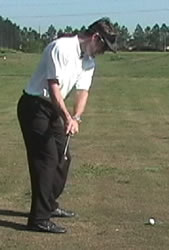 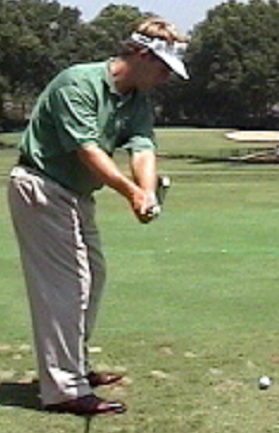
One of the very small nuances that is very
important in the one plane swing is the clockwise
rotation of the left arm. David Leadbetter
pointed this out in his book on Hogan's Five Fundamentals.
In a two plane swing, there is no rotation of the
forearm because you are trying to get the club up
and rotating the left arm makes the swing more "around"
as the club goes more into the "depth" dimension
of the swing. The rotation of the arm in the one plane
swing allows the left arm to more naturally swing
across the body. If you stand up and make a baseball
swing, you will notice that there is some clockwise
rotation of the left forearm. If
you do not allow the left forearm to rotate, the club
will be "maneuvered" onto a more upright
plane rather than being allowed to "swing"
on it's natural, more around plane.
This is not something that you will concsiously do
if you allow yourself to make a natural swing, it
is something that will happen on its own. I simply
point it out here because you may have heard not to
allow the left forearm to roll, which I believe is
true for a two plane swing, but not true for a one
plane swing. I also point it out
here because I don't recall Hardy talking about it
and I think it is important.
2. The left arm stays connected to the chest and rotates
One of Hardy's key fundamentals is to keep
the arms in close to the body with the left arm connected
to the chest.
The left arm staying connected
to the chest is a key element in a one plane swing
that allows the body to control the arms - a key to
power and accuracy. As I mentioned,
Hogan talked about this in his book, Five Fundamentals.
Both arms stay close to the body to decrease width
and give control of the golf club over to the torso,
removing the responsibility from the much more difficult
to control arms. This allows you to use the big muscles
of your body to swing the club because the arms are
a completely unreliable source of power and control.
This swinging motion happens naturally because the
arms are simply being led by the rotating body and
are being allowed to swing back behind the chest similar
to a baseball swing. You can clearly see here that
David's arms are continuing their very upward movement
whereas mine are swinging more around. A
simple way to look at this is that in a one plane
swing the arms and body are always in sync, with the
arms naturally swinging with the rotation of the body
on the same plane. In the two plane swing the body
rotates and the arms lift. There is NO lifting of
the arms in a one plane swing.

3. The
arms swing back on the same plane as the shoulders
This is where Hardy and Hogan differ significantly
from today's teaching. Both speak of how the left
arm swings on a plane that is very close to parallel
to that of the shoulders. In order to do this, you
may feel that you are swinging much more around than
up. The club is, however traveling up due to the steeper
shoulder plane established at address. You'll find
that it feels very natural to swing around your body
without lifting your arms. It is just how you would
swing a baseball bat or an axe.
Observe the photo below of Steve Flesch from 2003,
before he started to work with Butch Harmon on swinging
more upright, or more on two planes. At the top of
the swing, his left arm and shoulders are perfectly
on plane together.
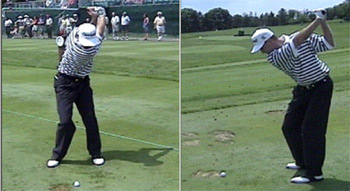
Top of the Swing
Compare the following two photos
of me and David Toms. Both of us have arrived in solid
positions at the top, but there are obvious differences.
First, David's hands are directly above his right
shoulder, a textbook position for a two plane swing.
My hands are outside my right shoulder and are further
"behind" my body, as Hardy would put it.
Toms' right arm has swung up and away, disconnecting
from his body. Also, note the flatter shoulder plane
that David has at the top of the swing.
On the downswing, David's arms must drop a great distance
to get back on plane. He must delay his body turn
until his arms have dropped back in front of his chest.
My arms do not have to drop because they are already
on plane with my shoulders. My only task from here
is to rotate my body back the left. In my own experience
with the swing, from this position I must rotate like
hell back to the left to get my body out of the way.
Hogan talked about how hard he drove with his lower
body in his book and in Jody Vasquez' book "Afternoons
with Mr. Hogan" (a great read, btw) he talked
about how one of Hogan's secrets was to drive his
right knee "into the back of the ball."
This, I think is a key to the one plane swing. Hardy
phrased it that "your body can turn fast enough."
I think they were saying the same thing in slightly
different ways. Either way, my interpretation of it
is to rotate like hell.
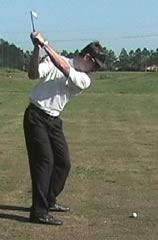 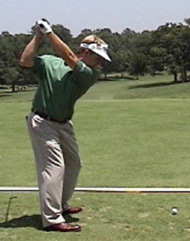
In order to arrive in
this one plane position at the top, the arms must
stay connected to the body. You can see that you could
place a headcover under each of my arms and they would
stay securely in place throughout the swing. This
is a drill that Hardy and others advocate for this
type of swing. My visual is that my left arm is velcroed
to my chest. I like this image because velcro gives
a little, allowing for some feeling in the arm, but
it also gives me the feeling that my arm is securely
held in place without me "holding" it in
place by being tense. I believe that the arm must
be allowed to swing into this position, not be forced
into it. You should feel as if you are in a very connected
and powerful position at the top of the swing, all
the while feeling alive and dynamic.
No swinging motion can get around the fact that the
body generates the power and the arms must be below
the shoulder plane at impact. Take a look at a photo
of Barry Bonds hitting a home run, or any baseball
player for that matter. You will see that their arms
are clearly below their shoulders for obvious reasons.
If Bonds started with his arms above his shoulders
before his swing, then he, too would be required to
"drop" the arms to get them beneath his
shoulder plane in order to use the rotational force
of his body to generate power. If he swung at a pitch
above his head, he would have no power as his arms
would be above his shoulder plane and he then could
only use his arms to generate bat speed. The difference
between a baseball and golf swing is that baseball
players rarely start their swing with their arms far
above their heads (with the exception being Julio
Franco). They always start with their arms on plane
with their shoulders so that there is nothing but
rotation in the swing. They don't struggle with the
timing needed to drop their arms back down on plane,
their arms are already on plane, all they need to
do now is rotate their body left as hard as they want
and let the arms trail behind their body. Notice how
Bonds' arms at impact will be well behind his quickly
rotating torso. His chest will be pointing toward
the pitcher while his lead arm will stil bel pointing
toward the ground.
In a one plane golf swing, the idea is that you are
simply duplicating these more natural swinging positions
by eliminating as many unnecessary moving parts as
possible. In this case, we want to get rid of the
dramatic upright swinging motion of the arms. Jim
Hardy believes that with the arms on plane, all one
has to do is rotate the body back to the left and
keep the arms behind my body.
Transition
The transition in any golf swing
is perhaps the most important move and the most difficult
for most to understand. It is what gives a golf swing
its athleticism, grace and power. In both swings,
the body must begin moving back to the target before
the club reaches the top of swing. In any good golf
swing, the arms do nothing active from the top of
the swing until they get back down to atleast hip
high, this allows them to store potential energy to
be used exclusively through the hitting area. The
longer they stay passive, the better, as this allows
the body to control the club rather than the arms.
The transition is the single most important move for
storing power in the golf swing. It is the transition
that allows the golfer to maintain lag in the wrists
that allow the club to whip through impact with little
apparent effort from the body. Ben Hogan is, of course,
the absolute master of this. Hogan began moving his
body back to the target well before he reached the
top of the swing and he, himself, stressed the emphasis
of getting the hips moving while the arms stay passive.
Hogan said that his "arms were getting a free
ride." For many, getting the lower body to move
in one direction while the club continues to move
back is a difficult task. One way I teach this move
is this that as long as the club is moving back away
from the target on the backswing, the body can be
rotating back away from the target. However, after
the club is perpendicular to the ground, it begins
moving "back" toward the target as it approaches
the top of the swing. It is during this time that
the body must be "preparing" to move back
toward the target. It does not happen this early,
but if you think of it happening in this way it will
give the body time to respond to the minds instructions
while you are learning the idea. It is at this point,
when the body begins rotating back to the left that
you can't rotate too fast. The jeopardy in the two
plane swing of rotating the body too fast is the don't
have time to get back down on plane and they get stuck
behind you. In the one plane swing, that is the exact
desired effect. You want the left arm to feel as if
it were being drug or forced through the downswing
by the body. It is as if the left arm were velcroed
to the chest, very relaxed but whipping through impact.
If your transition is poor and doesn't "trap"
or "catch" the left arm against the chest,
you will swing over the top with the arms as you begin
to rotate your upper body back to the target with
the lower body still "in the way." Hardy
didn't talk much about the transition on The Golf
Channel, but for me it makes a golf swing. Hogan also
believed this and gave it concern in his book Five
Lessons. I cannot emphasize enough the importance
of the transtion. It is the transition that stretches
the muscles to their fullest extent and this stretching
is what allows them to "snap" back like
a rubber band to generate tremendous speed with very
little effort.
Consider the two photos below of me at impact hitting
an 8 iron. In the swing on the left, I have purposely
made a "late" transition. This has forced
my arms over the top and caused me to come down on
the ball too steep. You'll notice that my arms are
in front of my body, rather than behind it. I am a
bit scrunched up as my arms didn't have room to swing
with my hips not getting out of the way. In the second
picture, you can see how my better transition has
allowed my arms to be pulled by my body rather than
swing back in front of it. While it is difficult to
see in still pictures, the consistency in ball striking
is night and day and the effort required to hit the
much more dynamic shot is significantly less.

Downswing
In initiating the downswing, there
are several things to consider. The mantra of the
one plane swing might be something like "get
to the left side" or "rotate the shoulders
on the same plane." While these are proper things
that you need to do in the downswing, I first will
address the one thing that you must NEVER do. It is
a killer to the swing, one plane or two. Your right
hip must never, ever, under any circumstance kick
toward the ball at the start of the downswing. This
move is an absolute destroyer of all golf swings and
is something that I struggled with a great deal. It
is such a quick, seemingly harmless motion, but it
changes more things in your downswing than any other
single action. It is a problem that plagues many,
many golfers at all levels. When the right hip kicks
in toward the ball during the transition, the spine
angle changes, becoming more upright. No matter how
hard you try and maintain your spine angle, your lower
back will straighten, even if you manage to maintain
the angle with your mid and upper back. Note the picture
below. The yellow line represents the spine angle
I established at address and maintained throughout
my backswing. However, I initiated my downswing by
kicking in my right hip toward the ball rather than
rotating my body hard to the left. This puts me in
a "stuck" body position where I must work
extra hard to save the shot. My arms are forced onto
a steeper plane and to the outside of my turn. My
spine angle is becoming more upright and I am, in
effect, coming out of the shot because my hips never
cleared properly during the transition. I can attest
first hand that this is a dreadful position to try
and play from consistently. Not only is it bad for
accuracy, it's also bad for the back. If you perform
the one plane swing properly and initiate the transition
correctly, you will not have to struggle with this
swing killer any longer.

Shoulder Turn vs. Shoulder Tilt
One of the most eye opening things I thought
that Hardy spoke about was the shoulder turn/tilt.
Hardy places an emphasis on the way the shoulders
rotate in the one plane golf swing. He believes, they
must rotate perpendicular to your spine at all times.
If they do not, they are tilting, not turning. On
the backswing, most all better golfers turn their
shoulders rather than tilt them, but it is during
the downswing that the turning becomes more of a concern.
If your right hip moves toward the target as I mentioned
above, the shoulders will stop turning left and "tilt."
You can see this in the pictures of me above. At impact,
my left shoulder has stopped rotating around to the
left and now my right shoulder is coming underneath.
Because this is something I struggled with for years
in a two plane swing, I feel I can speak authoritatively
on the subject. The only thing that I believe that
fixes this "tilting" through impact caused
by the right hip kicking in toward the ball is an
aggressive transition and rotation of the hips and
core to the left while the shoulders stay back a little.
This creates a stretch between the shoulders and the
hips, storing energy that allows them to snap through
impact. This is exactly in line with what Hogan spoke
about in his book and I have found it to be true in
my swing as well.
Click
here to learn how to do the one plane swing and stop
reading about it >>> |
